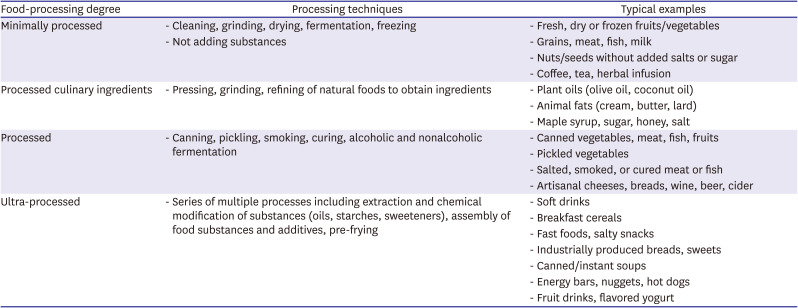This article has been
cited by other articles in ScienceCentral.
It is needless to say that a healthy balanced diet is recommended not only to lower blood pressure (BP) but also to prevent cardiovascular disease.
1)2) Traditionally, the source of the nutrients, for example, increased consumption of vegetables, fresh fruits, fish, nuts, and unsaturated fatty acids and low consumption of red meat; and consumption of low-fat dairy products are paid attention.
3) Also it is needless to say that high salt intake is important risk factor of cardiovascular disease.
4) However, food processing can also influence diet quality. Moreover, it might be related with cardiovascular disease.
Ultra-processed food (UPF) is salty and sweet, industrially produced, and primarily consists of compounds derived from whole food (
Table 1). What is important is that UPFs do not only include so-called junk foods but also many foods that are marketed and perceived as healthy, such as flavored yogurts, reduced-calorie/low-fat products, breakfast cereals, and products “enriched” with beneficial nutrients.
5) Therefore they can be mistaken as healthy diets.
Table 1
Category of foods according to food-processing as defined by the NOVA framework5)

|
Food-processing degree |
Processing techniques |
Typical examples |
|
Minimally processed |
- Cleaning, grinding, drying, fermentation, freezing |
- Fresh, dry or frozen fruits/vegetables |
|
- Not adding substances |
- Grains, meat, fish, milk |
|
- Nuts/seeds without added salts or sugar |
|
- Coffee, tea, herbal infusion |
|
Processed culinary ingredients |
- Pressing, grinding, refining of natural foods to obtain ingredients |
- Plant oils (olive oil, coconut oil) |
|
- Animal fats (cream, butter, lard) |
|
- Maple syrup, sugar, honey, salt |
|
Processed |
- Canning, pickling, smoking, curing, alcoholic and nonalcoholic fermentation |
- Canned vegetables, meat, fish, fruits |
|
- Pickled vegetables |
|
- Salted, smoked, or cured meat or fish |
|
- Artisanal cheeses, breads, wine, beer, cider |
|
Ultra-processed |
- Series of multiple processes including extraction and chemical modification of substances (oils, starches, sweeteners), assembly of food substances and additives, pre-frying |
- Soft drinks |
|
- Breakfast cereals |
|
- Fast foods, salty snacks |
|
- Industrially produced breads, sweets |
|
- Canned/instant soups |
|
- Energy bars, nuggets, hot dogs |
|
- Fruit drinks, flavored yogurt |

Recently, several epidemiologic studies suggest that higher consumption of UPF is associated with cardiovascular disease. For example, the Framingham Offspring Study reported that each additional daily serving of UPF was associated with a 7% increase in the cardiovascular disease risk.
6) However, the exact mechanisms linking UPF to cardiovascular disease risk is still unclear. Suggested key mechanisms include altered serum lipid concentrations, modified gut microbiota and host–microbiota interactions, obesity, inflammation, oxidative stress, hyperglycemia, insulin resistance, and hormonal imbalances.
7) In this issue of
Korean Circulation Journal, Shim et al.
8) reported the association of UPF consumption and the BP. By analyzing the food intake survey based on the 24-hour recall method of the Korea National Health and Nutrition Examination Survey (KNHANES VII) 2016–2018, they reported that the upper tertile of UPF consumption was significantly associated with elevated BP compared with the lower tertile, after adjusting for potential confounders. Also, a linear trend was observed for elevated BP across the tertile of the dietary energy contribution of UPF.
Although this study suggested the new link of the food processing method and BP, there were several limitations. Most importantly, there are several compounds from different sources in UPF. Therefore, it is still remained unclear which is more closely related between the compound and the processing method in the cardiovascular disease risk. Of course it might be difficult to discriminate the impact of two component, but as several food in UPF category, for example, flavored yogurts or cereals, were once regarded as healthy food, it should be confirmed. For this issue, Shim et al.
8) included the Korean Health Eating Index (KHEI) score to adjust overall diet quality and showed that the association was still significant even adjusting KHEI score. Another limitation is the 24-hour recall method used for diet analysis. The validity of the 24-hour recall method was not high, although it has been widely applied in national nutrition surveys as well as epidemiologic studies.
It is always pleasant to watch researchers focus on specific topics and achieve continuous research results. The authors of this study have continuously researched the impact of diet in cardiovascular disease, including the diet management in hypertensive population.
9)10) Also, they recently they reported that a high-quality diet was positively associated with BP control in hypertensive patients.
11) We wish their continuous research journey to find the new therapeutic strategy of cardiovascular prevention and disease control.
In conclusion, it is still valid that the source of the nutrients is important in cardiovascular healthy. But recent paper in this journal broadened the sight that food processing can also influence diet quality and moreover cardiovascular disease.

